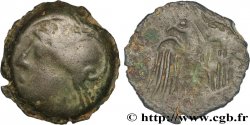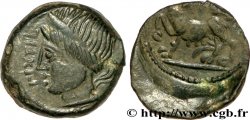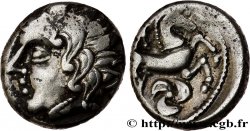bga_472575 - GALLIA - CARNUTES (Beauce area) Huitième de statère d’or à l’aigle à gauche
Not available.
Item sold on our e-shop (2018)
Price : 380.00 €
Item sold on our e-shop (2018)
Price : 380.00 €
Type : Huitième de statère d’or à l’aigle à gauche
Date: Ier siècle avant J.-C.
Mint name / Town : Chartres (28)
Metal : gold
Diameter : 10 mm
Orientation dies : 6 h.
Weight : 0,82 g.
Rarity : R3
Coments on the condition:
Petite monnaie sur un flan ovale, avec une usure marquée
Predigree :
Cet exemplaire provient de la collection Raymond D. (1948-2017), il a été acquis auprès de Mr. S. H. le 20 sept 2005.
Obverse
Obverse legend : ANÉPIGRAPHE.
Obverse description : Tête à droite, la chevelure en grosses mèches.
Reverse
Reverse legend : ANÉPIGRAPHE.
Reverse description : Aigle à gauche, une croix inscrite dans une rouelle perlée dans les serres ; un croissant au-dessus de l’aile.
Commentary
Ce monnayage divisionnaire d’or est de mieux en mieux connu, mais reste très rare ! Le style de portrait de cette monnaie est intéressant, relativement classique. Le revers à gauche semblerait plus rare que celui à droite (?) ;il manquait au Nouvel Atlas et un exemplaire provenant de Bazoches-les-Hautes a été rajouté dans le Supplément, sous le DT. S 2568 A.








 Report a mistake
Report a mistake Print the page
Print the page Share my selection
Share my selection Ask a question
Ask a question Consign / sell
Consign / sell
 Full data
Full data









